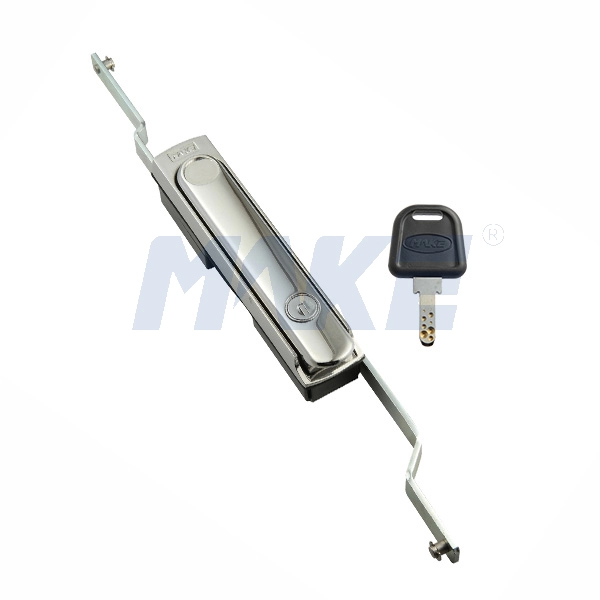Industrial locks refer to locks used in industrial production and commercial application, which are widely used in intelligent self-service terminals, personal computers, vehicles, storage equipment, power transmission and distribution and other fields. Tiandi Rod Control Lock is a common type of industrial lock.

Tiandi Rod Control Lock is generally used on the door frames of high and low voltage cabinets, power distribution cabinets, servers and other equipment to protect the normal operation of components. Different from general industrial locks, Tiandi Rod Control Lock generally drives the connecting rod in the metal cabinet door to move up and down through the rotation of the lock cylinder to open and close the cabinet door. The lock uses the connecting rod as a positioning piece to fix the position. The connecting rod is installed on the longitudinal axis of the side near the plane of the door panel (close to the opening and closing position of the door). When unlocking and closing, the connecting rod will swing up and down to unlock or lock. The operating device, that is, the lock cylinder, is located on the plane of the door panel to control the upper and lower connecting rods. So what are the advantages of Tiandi lock compared with other industrial locks?
First of all, the Tiandi Rod Control Lock is relatively firm. For some large-scale industrial locks used in high and low voltage cabinets, power distribution cabinets and servers, besides high requirements for safety performance, they also need very high stability. The traditional rod control lock has unstable locks, which brings potential safety hazards to industrial equipment. The Tiandi Rod Control Lock has locked arms above and below, which are used to fix on the door frame. At the same time, the special structure that the operating device is located on the side makes the Tiandi Rod Control Lock more unbreakable during use.
 Secondly, the Tiandi Rod Control Lock is very convenient to install and unlock. The lock has a simple structure, and it is easy to unlock and close. When it needs to be opened, it only needs to lift the key while rotating it, and the handle rotates 90 degrees to drive the shell assembly to open it, which has strong maneuverability and is more convenient to unlock when some emergencies occur. In terms of installation, the advantages of Tiandi Rod Control Locks are more obvious: only the upper and lower locking arms need to be installed at the corresponding positions, and the damage to the cabinet door is less.
Secondly, the Tiandi Rod Control Lock is very convenient to install and unlock. The lock has a simple structure, and it is easy to unlock and close. When it needs to be opened, it only needs to lift the key while rotating it, and the handle rotates 90 degrees to drive the shell assembly to open it, which has strong maneuverability and is more convenient to unlock when some emergencies occur. In terms of installation, the advantages of Tiandi Rod Control Locks are more obvious: only the upper and lower locking arms need to be installed at the corresponding positions, and the damage to the cabinet door is less.
MAKE Tiandi Rod Control Locks are mostly heavy-duty handle locks, which are made of high-quality materials such as zinc alloy and carbon steel. The surface is treated with high quality, smooth and flat, and the appearance is simple and decent. Equipped with a high-security key system, it can be used smoothly. In addition to Tiandi Rod Control Locks, MAKE also owns a variety of high-quality and comprehensive industrial lock products, such as plane locks, top cover locks and handle locks, which are diverse in variety and comprehensive in coverage. With high-quality products, they are selected and deeply trusted by customers! If you want to know more about industrial locks, please contact us!

Tiandi Rod Control Lock is generally used on the door frames of high and low voltage cabinets, power distribution cabinets, servers and other equipment to protect the normal operation of components. Different from general industrial locks, Tiandi Rod Control Lock generally drives the connecting rod in the metal cabinet door to move up and down through the rotation of the lock cylinder to open and close the cabinet door. The lock uses the connecting rod as a positioning piece to fix the position. The connecting rod is installed on the longitudinal axis of the side near the plane of the door panel (close to the opening and closing position of the door). When unlocking and closing, the connecting rod will swing up and down to unlock or lock. The operating device, that is, the lock cylinder, is located on the plane of the door panel to control the upper and lower connecting rods. So what are the advantages of Tiandi lock compared with other industrial locks?
First of all, the Tiandi Rod Control Lock is relatively firm. For some large-scale industrial locks used in high and low voltage cabinets, power distribution cabinets and servers, besides high requirements for safety performance, they also need very high stability. The traditional rod control lock has unstable locks, which brings potential safety hazards to industrial equipment. The Tiandi Rod Control Lock has locked arms above and below, which are used to fix on the door frame. At the same time, the special structure that the operating device is located on the side makes the Tiandi Rod Control Lock more unbreakable during use.
 Secondly, the Tiandi Rod Control Lock is very convenient to install and unlock. The lock has a simple structure, and it is easy to unlock and close. When it needs to be opened, it only needs to lift the key while rotating it, and the handle rotates 90 degrees to drive the shell assembly to open it, which has strong maneuverability and is more convenient to unlock when some emergencies occur. In terms of installation, the advantages of Tiandi Rod Control Locks are more obvious: only the upper and lower locking arms need to be installed at the corresponding positions, and the damage to the cabinet door is less.
Secondly, the Tiandi Rod Control Lock is very convenient to install and unlock. The lock has a simple structure, and it is easy to unlock and close. When it needs to be opened, it only needs to lift the key while rotating it, and the handle rotates 90 degrees to drive the shell assembly to open it, which has strong maneuverability and is more convenient to unlock when some emergencies occur. In terms of installation, the advantages of Tiandi Rod Control Locks are more obvious: only the upper and lower locking arms need to be installed at the corresponding positions, and the damage to the cabinet door is less.MAKE Tiandi Rod Control Locks are mostly heavy-duty handle locks, which are made of high-quality materials such as zinc alloy and carbon steel. The surface is treated with high quality, smooth and flat, and the appearance is simple and decent. Equipped with a high-security key system, it can be used smoothly. In addition to Tiandi Rod Control Locks, MAKE also owns a variety of high-quality and comprehensive industrial lock products, such as plane locks, top cover locks and handle locks, which are diverse in variety and comprehensive in coverage. With high-quality products, they are selected and deeply trusted by customers! If you want to know more about industrial locks, please contact us!

 Español
Español 中文
中文
